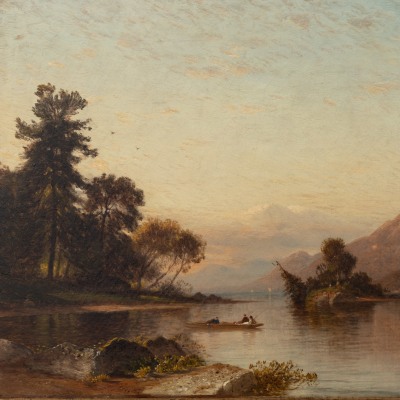
(1832–1920)
Samuel Colman, Jr., was born in Portland, Maine, and moved with his father, a bookseller and publisher, to New York City. By the age of 18 he had decided to become an artist, and probably began his studies by taking lessons with Asher B. Durand around 1850. After his successful debut at the National Academy of Design in 1851, he painted scenes of the Adirondack and White Mountains in a Hudson River School style. In 1860 he traveled to Europe, studying with Thomas Couture and traveling through France, Switzerland, Italy, as well as Spain and Morocco, which were seldom visited on the Grand Tour. Returning to New York in 1862, he secured his artistic reputation with some of the first American views of Spain and Morocco, as well as highly finished American scenes.
Ever the adventurer, Colman visited the American West in 1870, Europe from 1871 to 1875, the West Coast in 1886, 1888, 1892, and 1898, Mexico in 1892, 1894, and 1904, and the Canadian Rockies in 1905 and 1906. He was also one of the most progressive American artists of his generation, ably adopting the European trends that swept the American art world in the 1870s, and playing a leading role in the Aesthetic Movement and the revival of watercolor painting and etching. He amassed an impressive collection of Asian decorative arts and had a strong influence on the taste of the leading collector Henry O. Havemeyer. In his later years, he wrote treatises on aesthetic theory.
Colman exhibited his work at the National Academy of Design, Brooklyn Art Association, Boston Athenaeum, Boston Art Club, Pennsylvania Academy of the Fine Arts, Maryland Historical Society, and the Art Institute of Chicago. He was a National Academician, the first president of the American Watercolor Society, and a member of the Society of American Artists and New York Etching Club. Colman’s works can be found in the collections of The Metropolitan Museum of Art, New-York Historical Society, National Academy Museum, and Brooklyn Museum, New York; Hudson River Museum, Yonkers, New York; Wadsworth Atheneum, Hartford, Connecticut; Museum of Fine Arts, Boston; Harvard Art Museum, Cambridge, Massachusetts; National Gallery of Art and Smithsonian American Art Museum, Washington, D. C.; and the Art Institute of Chicago.
